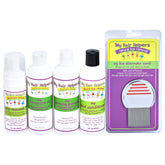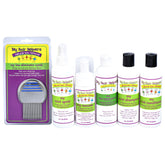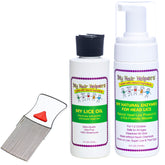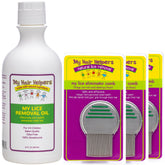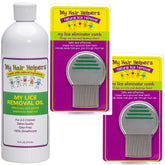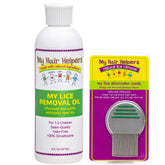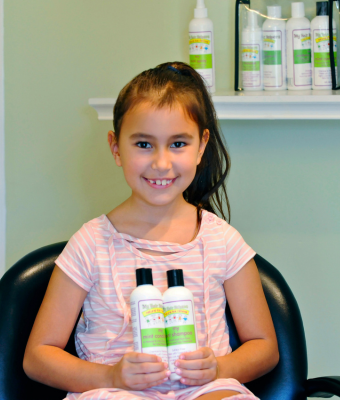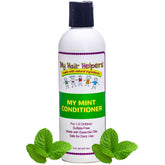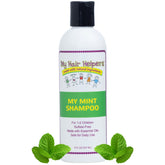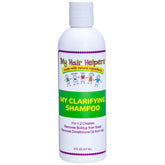COMB THROUGH METHOD FOR LICE

Holiday travel can bring plenty of joy—visiting relatives, catching up with old friends, and celebrating the season. However, it can also expose families to a variety of germs and pesky parasites, including head lice.
Whether you stayed with relatives or traveled by plane, bus, or train, close quarters and shared bedding or hats can increase the risk of bringing lice home. One of the most effective ways to detect and manage lice early is through a proper comb-through method. Below is a refresher on how to check for lice eggs (nits) and ensure a fresh start to the new year.
Why Use the Comb-Through Method?
Lice eggs (nits) can be difficult to spot until they hatch or until the infestation becomes more severe. Regular comb-throughs can catch an infestation before it escalates. Unlike a quick “fingertip search” or a visual inspection, the comb-through method systematically parts and combs each section of hair to spot both lice and nits. Performing a comb-through on a routine basis—especially after high-risk travel periods—can prevent a few stray nits from turning into a full-blown outbreak.
What You’ll Need
-
A Nit Comb: Choose a metal comb specifically designed to drag out lice and nits. The teeth should be close together to trap even the smallest eggs.
-
Conditioner or Detangling Spray: Applying a leave-in conditioner or detangler can help the comb glide more smoothly through hair and reduce discomfort.
-
Bright Lighting: Natural sunlight or a well-lit area helps you see eggs more easily. You might also use a headlamp or bright desk lamp if indoors.
-
Towels or Paper Towels: Have a place to wipe the comb after each pass. This allows you to inspect what the comb catches and prevents reintroducing any lice or eggs back into the hair.
-
Clips or Hair Ties: These can help section off the hair, making it easier to tackle one region at a time.
Step-by-Step Comb-Through Procedure
Set Up the Space
Choose a comfortable seat with good lighting. Protect clothing and chairs with a towel or use a hairdressing cape to catch stray hairs or falling lice.
Dampen and Detangle
Lightly mist the hair with water or use a detangler/conditioner to make the combing process smoother and less painful. Comb through gently with a regular brush or wide-toothed comb first to remove any knots.
Section the Hair
Part the hair into manageable sections (4–6, depending on thickness). Clip or tie back each section to ensure you don’t miss any areas.
Comb Thoroughly, Section by Section
Start at the scalp and slowly drag the lice comb all the way to the hair tips. After each pass, wipe the comb onto a paper towel or towel to check for adult lice, nymphs, or nits. Make several passes over each section, slightly overlapping to ensure full coverage. Eggs will appear as tiny, oval-shaped specks firmly attached to hair shafts, often near the scalp.
Continue Until All Sections Are Done
Keep track of any suspicious findings. If you spot multiple eggs or live lice, you’ll need to address them right away right away.
Clean Up
Dispose of used paper towels in a sealed bag. Soak the comb in hot, soapy water or a disinfectant solution for at least 10 minutes to kill any remaining eggs or lice.
What to Do If You Find Lice Eggs
Lice eggs (nits) can sometimes be confused with dandruff or hair debris. If the speck is firmly attached to the hair shaft and doesn’t brush away easily, it’s likely a nit. Consider professional lice removal services or natural head lice products, depending on severity. Consistency in follow-up treatments is key to breaking the lice life cycle.
If you find lice in one person, there’s a possibility others have been exposed. Regular checks for every member can help contain the spread. Launder pillows, hats, and linens in hot water. Vacuum furniture and carpets to pick up any stray hairs that might have nits attached.
Even after an initial treatment, continue weekly or twice-weekly comb-throughs for at least two weeks to confirm there’s no re-infestation.
Conclusion
The holiday season can sometimes lead to unwelcome stowaways making the journey home with you. A careful comb-through method is the best line of defense to ensure any stray lice or eggs are caught and dealt with swiftly.
By staying vigilant and performing regular checks—especially right after travel—you’ll help maintain a lice-free home, saving everyone the stress and frustration of a more serious infestation. Here’s to a new year free of itch and worry! Shop My Hair Helpers Lice Eliminator Comb and Lice Defense Products today!


